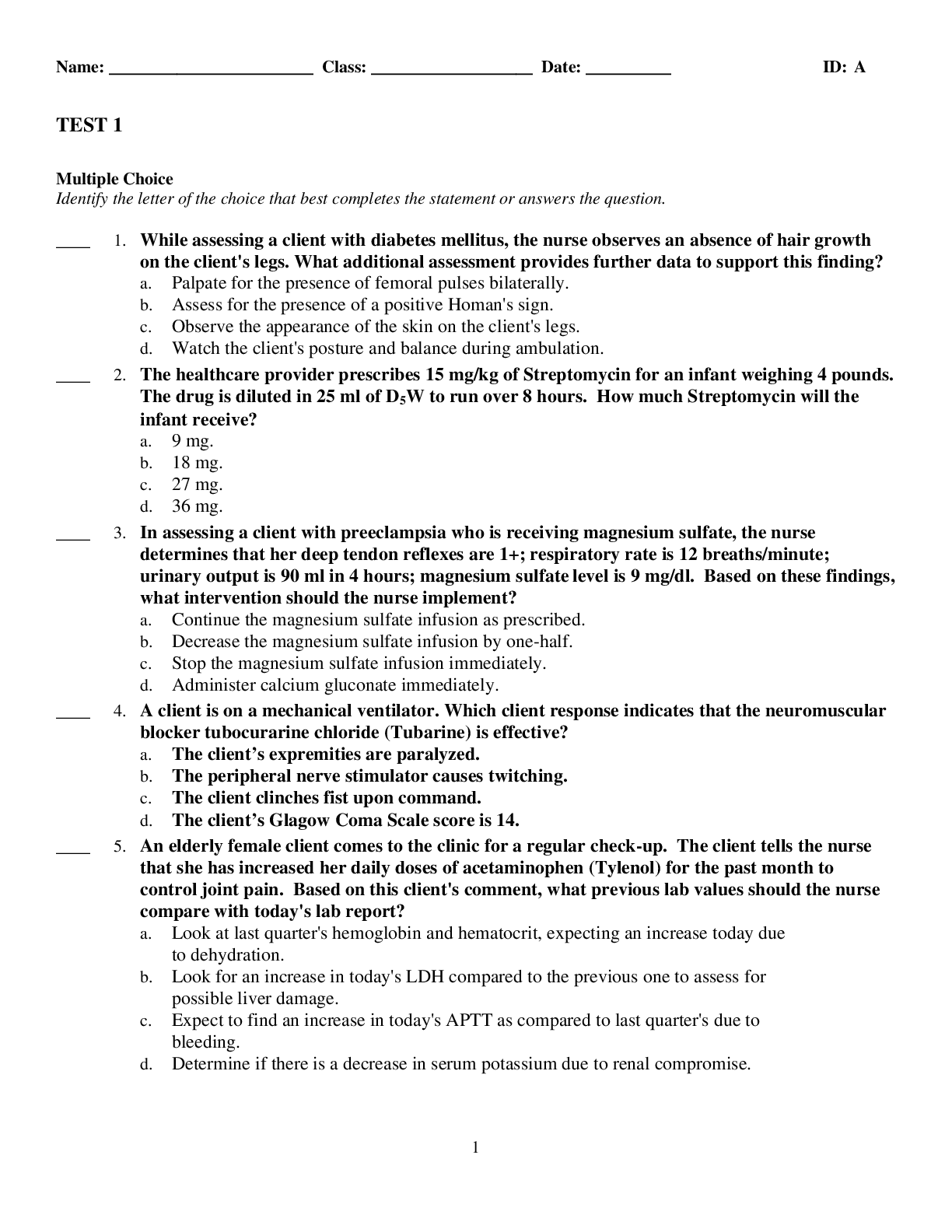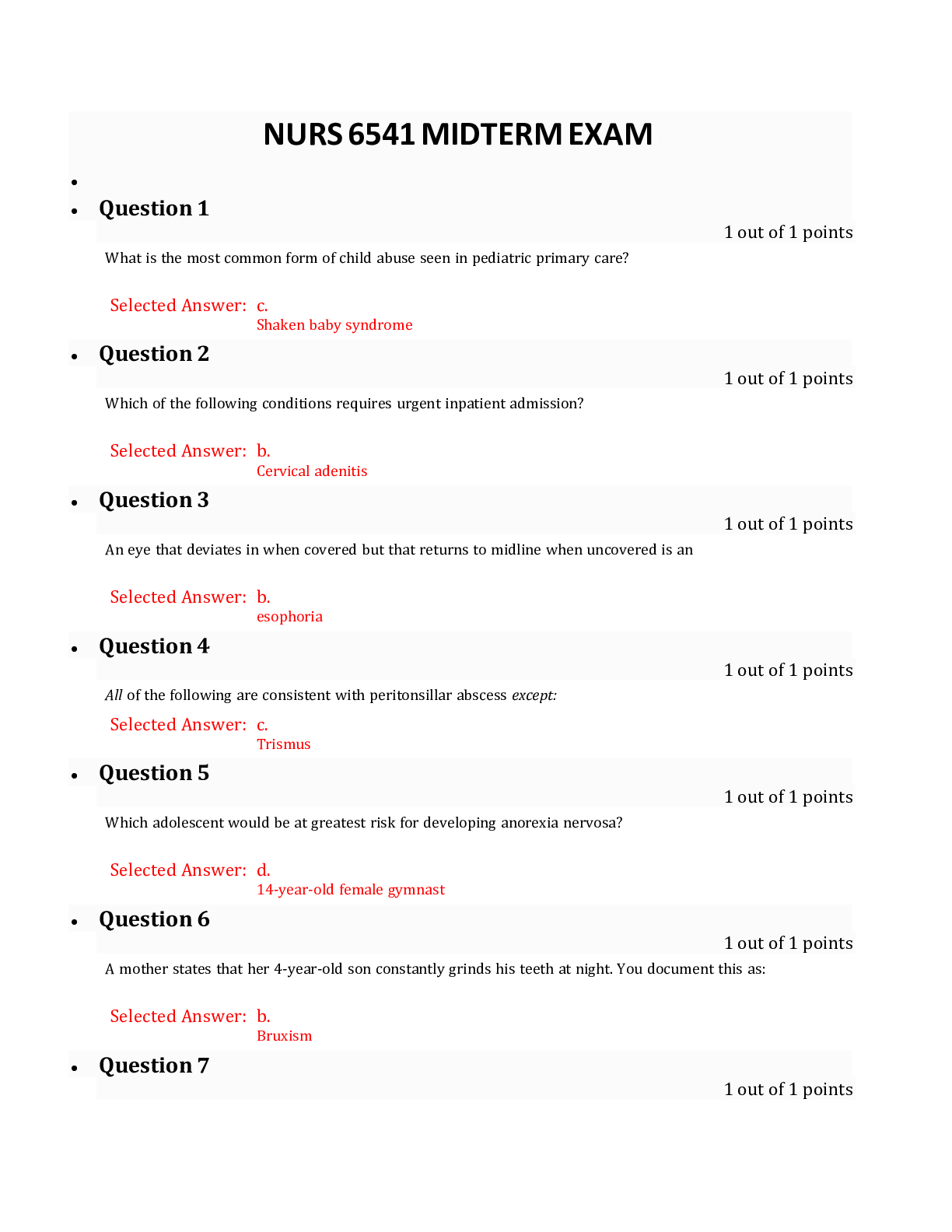*NURSING > EXAM > HESI RN Health Assessment Questions and Answers (Latest Update) Already GRADED A (All)
HESI RN Health Assessment Questions and Answers (Latest Update) Already GRADED A
Document Content and Description Below
A client is reporting chest pain. What statement made by the client helps the nurse to understand the client has a naturalistic belief in the cause of illness? A. "My life is really out of balance.... " B. "I knew I should have changed my diet." C. "I should have gone to church last week." D. "I forgot to take my medicines last night." A. "My life is really out of balance." A nurse is working in a healthcare facility that serves a diverse population. What action(s) by the nurse will allow the nurse to empathize with and understand this population? (Select all that apply.) A. Be open to people who are different. B. Have a curiosity about people. C. Become culturally competent. D. Interact with each person in the same way. E. Request nurses take care of patients with the same ethnicity. F. Always request an interpreter for people from other countries. A. Be open to people who are different. B. Have a curiosity about people. C. Become culturally competent. Which statement is accurate about assessing the spleen? A. It must be enlarged at least three times normal size for it to be palpable B. It is easily felt by reaching the left hand behind the 11th and 12th ribs. C. It is normally felt by rolling the client on the right side and palpating. D. It is a firm mass palpated slightly left of midline in the upper abdomen. A. It must be enlarged at least three times normal size for it to be palpable What is the best place for the nurse to hear lower lobe lung sounds with a stethoscope? A. Posterior chest below the 3rd intercostal space B. Posterior-axillary line at the 4th intercostal space C. Anterior chest at the level of the 4th intercostal space. D. Anterior-axillary line at the 5th intercostal space. A. Posterior chest below the 3rd intercostal space The nurse is assessing a client who has a history of mitral stenosis. How should the nurse assess this client with a stethoscope to listen for this condition? A. Place the bell on the 5th intercostal space, left midclavicular line. B. Place the bell on the 2nd intercostal space, left midclavicular line. C. Put the diaphragm on the 5th intercostal space, left sternal border. D. Put the diaphragm on the 2nd intercostal space, left sternal border. A. Place the bell on the 5th intercostal space, left midclavicular line. The nurse is assessing a client who has a history of aortic regurgitation. Where should the nurse place the stethoscope diaphragm to listen for this condition? A. 2nd intercostal space along the right sternal border B. 2nd intercostal space along the left sternal border. C. 3rd intercostal space on the right midclavicular line D. 5th intercostal space on the left midclavicular line A. 2nd intercostal space along the right sternal border The client is experiencing severe pruritis and small papules and burrows on areas over one hand and the inner thighs. Which assessment data best explains the condition the client is experiencing? A. The client works in a daycare setting that has had a scabies outbreak. B. The client has been using a chemical stripping agent for home remodeling. C. The client has a family history of psoriasis in both parents and a sibling. D. The client routinely works with clay and paint as a hobby. A. The client works in a daycare setting that has had a scabies outbreak. A client comes to the clinic with a report of fever and a recent exposure to someone who was diagnosed with meningitis. Which nursing assessment should be completed during the initial examination of this client? A. Level of consciousness B. Gait characteristics C. Presence of trauma D. Bladder control ability. A. Level of consciousness A client reports feeling increasingly fatigued for several months, and the nurse observes that the client's lips are pale. Which additional data should the nurse collect based on this presentation? A. Current alcohol and tobacco use B. A 24-hour dietary recall C. Use of vitamin and iron supplements D. Daily pattern of oral hygiene practices C. Use of vitamin and iron supplements The nurse is assessing a client who has experienced a sudden onset of hearing loss in the right ear. Which finding should alert the nurse to a potentially serious medical condition that requires further evaluation? A. The client works in a busy office setting B. There is no sign of associated infection C. The client has no prior history of hearing loss D. The hearing loss involves high frequencies B. There is no sign of associated infection The client reports to the nurse a recent exposure to the mumps. Which assessment finding suggests the client has contracted the mumps? A. Enlargement centered along the anterior lower neck region B. Swelling anterior to the ear lobe on one side of the face C. Generalized rounded shape of the face D. Paralysis on one side of the face B. Swelling anterior to the ear lobe on one side of the face A client states that she had a mastectomy of her left breast last year and now experiences lymphedema. What should the nurse expect to find when examining the client? A. Swelling of the left arm and non-pitting edema. B. Bilateral swelling of the arms with weakened pulses. C. Complaints of pain when taking the blood pressure on the affected side. D. Metastasis of cancer due to cancer being in the lymph nodes. A. Swelling of the left arm and non-pitting edema. What is the best nursing response to an older client who has not mentioned incontinence during a genitourinary assessment? A. Ask the client specifically about any leakage of urine. B. Document that the client reports having no incontinence C. Have the client cough and then check for urine leakage D. Determine if the client has ever had urinary tract surgery. A. Ask the client specifically about any leakage of urine. A client is in the clinic for a routine health examination. The nurse notices the client appears underweight. Which question is most important for the nurse to ask when completing the health history of this client? A. What types of food do you like or dislike? B. Have you experienced sudden weight loss? C. Do you use dietary supplements every day? D. Can you recall the last 24 hours of food intake? B. Have you experienced sudden weight loss? A client is in the clinic and is reporting lower abdominal pain and constipation. Which information is of greatest concern to the nurse when obtaining the health history from this client? A. Administration of rubeola vaccine at age 7. B. Removal of gallbladder 5 years ago. C. Family history of colon cancer on mother's side. D. Family history of hypertension on father's side. C. Family history of colon cancer on mother's side. Which information should the nurse obtain to identify the client's self-perception of health status? A. Vital signs B. Health history C. Informed consent D. Genetic predisposition B. Health history During the initial assessment, the nurse notes that a client has blurred vision with cloudy lenses. Which condition should the nurse document? A. Pink eye B. Cataracts C. Glaucoma D. Corneal abrasion B. Cataracts While palpating a client's breasts, the nurse detects a nontender, solitary, round lobular mass that is solid and firm and slides easily through the breast tissue. The findings of this breast exam are consistent with which condition? A. Mastitis B. Paget disease C. Fibroadenoma D. Plugged mammary duct C. Fibroadenoma Which part of the body should the nurse examine when assessing for peripheral edema in a client with heart failure? A. Face B. Ankles C. Knees D. Jugular veins B. Ankles Which condition is indicated by a fluorescent, yellow-green color when the nurse uses a Wood's lamp to examine a client's skin lesions? A. Fungal infection B. Bacterial infection C. Allergic reaction D. Skin cancer A. Fungal infection The nurse is performing a routine physical examination on an adult client. When gather a health history, which question is included in the CAGE questionnaire? A. When did you have your last alcoholic drink? B. How does alcohol usually affect you? C. What is your favorite alcoholic drink? D. Have you ever felt guilty about your drinking? D. Have you ever felt guilty about your drinking? A client has just returned from the recovery room and asks to get out of bed to go to the bathroom. The nurse decides to obtain orthostatic vital signs first. How will the nurse position the client to begin this procedure? A. Lying B. Sitting C. Leaning D. Standing A. Lying The nurse is assessing a client for a hip flexion contracture. Which finding indicates a negative Thomas test when the client's right knee is brought toward the chest? A. The left leg internally rotates. B. The left leg rises off the table. C. The left leg remains on the table. D. The left leg externally rotates. C. The left leg remains on the table. An adult client is in the clinic for a regular physical examination. The nurse is assessing the client's hydration status by pinching then releasing the client's skin. Which finding is indicative of good hydration status? A. The skin remains tented. B. The skin appears blanched and returns to pink. C. The skin slowly falls back into place. D. The skin immediately returns to normal position. D. The skin immediately returns to normal position. The nurse is performing a thoracic assessment on a client with chronic asthma and hyperinflation of the lungs. Which finding should be expected for this client? A. Kyphosis B. Barrel chest C. Pectus Excavatum D. Pectus Carinatum B. Barrel chest The nurse performs a series of cranial nerve tests on a client with a head injury. Which test should the nurse use to assess damage to the first cranial nerve? A. Ask the client to count down from 100 by 7s for as long as possible. B. Occlude one nostril and have the client identify various odors. C. Have the client follow the tip of a moving penlight with the eyes. D. Tell the client to walk heel to toe in a straight line for nine steps B. Occlude one nostril and have the client identify various odors. Which tool should the nurse use when assessing the neurological status of a client with traumatic brain injury? A. Glasgow Coma Scale B. Braden Scale C. Numerical pain scale D. Cranial nerve examination A. Glasgow Coma Scale A client with dark skin is reporting a painful and itching area on the lower left leg. What should the nurse look for when assessing this client's skin for inflammation? A. Change in consistency B. Change in turgor C. Redness D. Pallor A. Change in consistency While assessing level of consciousness, the nurse finds that a client localizes to pain, is confused during conversation, and opens the eyes to sound. How should the nurse document the Glasgow score of this client? A. 12 B. 10 C. 9 D. 7 A. 12 Which question should the nurse ask in order to test a client's remote memory? A. What is your date of birth? B. Who is your current healthcare provider? C. What medications are you taking? D. How did you arrive at the hospital today? A. What is your date of birth? A client reports pain when taking a deep breath. Which lung auscultation sound should the nurse anticipate hearing? A. Pleural friction rub B. Rhonchus C. Coarse crackles D. Wheezing A. Pleural friction rub The nurse is examining the hip joint of a client who reports hip pain. Which other assessment is most helpful in determining the cause of the client's pain? A. Knee joint evaluation B. Cranial nerve testing C. Postural alignment D. Deep tendon reflexes A. Knee joint evaluation A postmenopausal female client is undergoing a routine physical examination. She has reported nothing out of the ordinary. When performing the examination of the genitourinary system, the nurse finds an irregularly enlarged uterus with firm, mobile, painless nodules in the uterine wall. How should the nurse explain this finding to the client? A. You have benign fibroid tumors, a common occurrence in women your age. B. This is a sign of uterine cancer and I will report this to the healthcare provider. C. This is a sign of endometriosis, so we will need to biopsy the lesions. D. This is a very common finding in pregnancy and it will go away. A. You have benign fibroid tumors, a common occurrence in women your age. The nurse is assessing the posterior pharynx during a physical examination. Which technique should the nurse use? A. Press the tongue down one side at a time with a tongue depressor. B. Ask the client to open the mouth and say "ah" C. Listen for hoarseness after asking the client to speak D. Palpate the neck and ask the client to swallow. A. Press the tongue down one side at a time with a tongue depressor. A nurse is completing a nutritional assessment with a client. What is the easiest method for the nurse to use to get information about the client's nutritional intake? A. 24-hour dietary recall B. Food diary C. Intake and output record D. Lab information (albumin, pre-albumin) A. 24-hour dietary recall The nurse is preparing to assess the hearing of a client with a history of prolonged exposure to occupational noise. Which hearing test provides the most reliable assessment of hearing status? A. Audiometry B. Whispered voice C. Weber. D. Rinne A. Audiometry The nurse palpates a weak pedal pulse in the client's right foot. Which assessment findings should the RN document that are consistent with diminished peripheral circulation? (Select all that apply.) A. Diminished hair on legs B. Bruising on extremities C. Skin cool to touch D. Capillary refill less than 3 seconds E. Darkened skin on extremities A. Diminished hair on legs C. Skin cool to touch Which findings can the nurse determine by palpating a client's skin? (Select all that apply.) A. Pruritis B. Diaphoresis C. Pallor D. Jaundice E. Scaling B. Diaphoresis E. Scaling The RN is caring for an Asian client who refuses to make eye contact during conversations. How should the RN assess this client's response? A. The client cannot understand the nurse. B. The client is uncomfortable with the nurse C. The client is treating the nurse with respect D. The client is purposefully disrespecting the nurse. C. The client is treating the nurse with respect The nurse is interviewing a client who reports having a persistent, productive cough during the winter caused by bronchitis. Which additional finding should the nurse assess for bronchitis? A. Phlegm production and wheezing B. Smoking history C. Hemoptysis D. Night sweats A. Phlegm production and wheezing A RN is performing a mini-mental state examination for a client who is being admitted to an assisted living community. Which communication techniques should the RN implement to decrease anxiety in the client? (Select all that apply.) A. Use simple sentences during the examination. B. Move to another question if the client seems confused. C. Reduce environmental detractors during the examination. D. Allow family to answer for the client to decrease frustration. E. Ask questions one at a time to decrease confusion. A. Use simple sentences during the examination. C. Reduce environmental detractors during the examination. E. Ask questions one at a time to decrease confusion. A client with progressive hearing loss appears distressed when the registered nurse asks open-ended questions about the client's health history. Which forms of communication should the RN use? A. Face the client so the client can see the RN's mouth. B. Increase one's speech volume when interacting with the client C. Repeat information to the client if misunderstood D. Check if the client's hearing aides are working properly E. Reduce environmental noise surrounding the client. A. Face the client so the client can see the RN's mouth. D. Check if the client's hearing aides are working properly E. Reduce environmental noise surrounding the client. Which action should the RN implement to complete an assessment for a client while using an interpreter? A. Ask closed-ended questions with the assistance of the interpreter. B. Maintain eye contact with the client while listening to the translation. C. Instruct interpreter to answer questions from interpreter's point of view. D. Protect the client's privacy by asking a limited number of questions B. Maintain eye contact with the client while listening to the translation. The nurse is completing a physical assessment of a client who fell from a tree. The client's abdomen is soft with hyperactive bowel sounds in all four quadrants. Which assessment technique should the nurse implement when evaluating the client's spleen? A. Elevate head of bed 30 degrees to percuss the spleen B. Palpate the splenic borders before percussing C. Percuss the splenic area as the client takes a deep breath D. Place client in a Trendelenburg position to isolate the spleen. C. Percuss the splenic area as the client takes a deep breath The nurse is assessing a client with liver disease who is jaundiced and exhibits scleral edema. During the health assessment, the nurse should implement which technique to determine evidence of hepatomegaly? A. Tap the liver's boundaries lightly with a percussion hammer to produce a sound. B. Push gently using fingers of both hands to determine the boundaries of the liver. C. Use a bouncing motion to tap the middle finger placed within boundaries of the liver. D. Cup hands and clap with alternating contact with the skin over regions of the liver. C. Use a bouncing motion to tap the middle finger placed within boundaries of the liver. When assessing facial nerve function of a 96-year-old, the nurse asks the client to smile in an exaggerated manner. Which finding is most important for the nurse to further assess? A. Only one side of the mouth moves when smiling. B. The client's teeth have a yellowed appearance. C. The client smiles broadly but appears anxious. D. The client asks the nurse to repeat the directions. A. Only one side of the mouth moves when smiling. A male executive is seen in the primary care clinic for a physical examination. While obtaining the client's health history, the nurse inquires about his drug and alcohol use. The executive denies drug use, but reports that he has "two glasses of wine" per night. Which response is best for the nurse to provide? A. "Your alcohol intake should be reduced by 8 ounces daily." B. "Does your use of alcohol concern any of your family members?" C. "What effect do you think your use of alcohol may have on you?" D. "The amount of alcohol you are drinking concerns me." C. "What effect do you think your use of alcohol may have on you?" When performing range of motion exercises on the joints of an older adult client, the nurse notes that joint range is greater with passive ranging than with active ranging. A goniometer indicates that this difference is as much as 15% in some joints. How should this finding be documented? A. Normal B. Expected in older adults C. Minor deviation D. Abnormal D. Abnormal During an external examination of the eyes, the nurse gently palpates the eyes while the client's eyelids are closed. The eyes are both very firm and resist movement back into the orbit. How should the nurse document this finding? A. Abnormal finding B. Expected finding C. Normal variation D. Sign of aging A. Abnormal finding The nurse enters an examination room to conduct a routine health assessment on an adolescent female client, who is accompanied by her mother. Which action by the nurse is likely to facilitate accurate responses to personal and social history questions? A. Include the mother in the interviewing process. B. Request that the mother leave the exam room C. Allow the client to broach discussion of any sensitive topics. D. Use highly structured and directed questions to explore sensitive topics. B. Request that the mother leave the exam room While performing a mental status exam, the nurse asks a client to remember three unrelated words and repeat them later. The client was able to repeat the words as directed. Which computer documentation is accurate? A. "Exhibits an above average intelligence." B. "Reflects no apparent lapses in concentration." C. "Demonstrates appropriate judgement in everyday scenario." D. "Short-term memory is intact." D. "Short-term memory is intact. [Show More]
Last updated: 8 months ago
Preview 1 out of 19 pages
Instant download

Buy this document to get the full access instantly
Instant Download Access after purchase
Add to cartInstant download
Also available in bundle (1)

HESI Health Assessment Exams and Study Materials PACKAGE DEAL (100% Guaranteed Pass
HESI Health Assessment Exams and Study Materials PACKAGE DEAL (100% Guaranteed Pass
By A+ Solutions 8 months ago
$20.5
11
Reviews( 0 )
Document information
Connected school, study & course
About the document
Uploaded On
Oct 07, 2023
Number of pages
19
Written in
Additional information
This document has been written for:
Uploaded
Oct 07, 2023
Downloads
0
Views
134






.png)






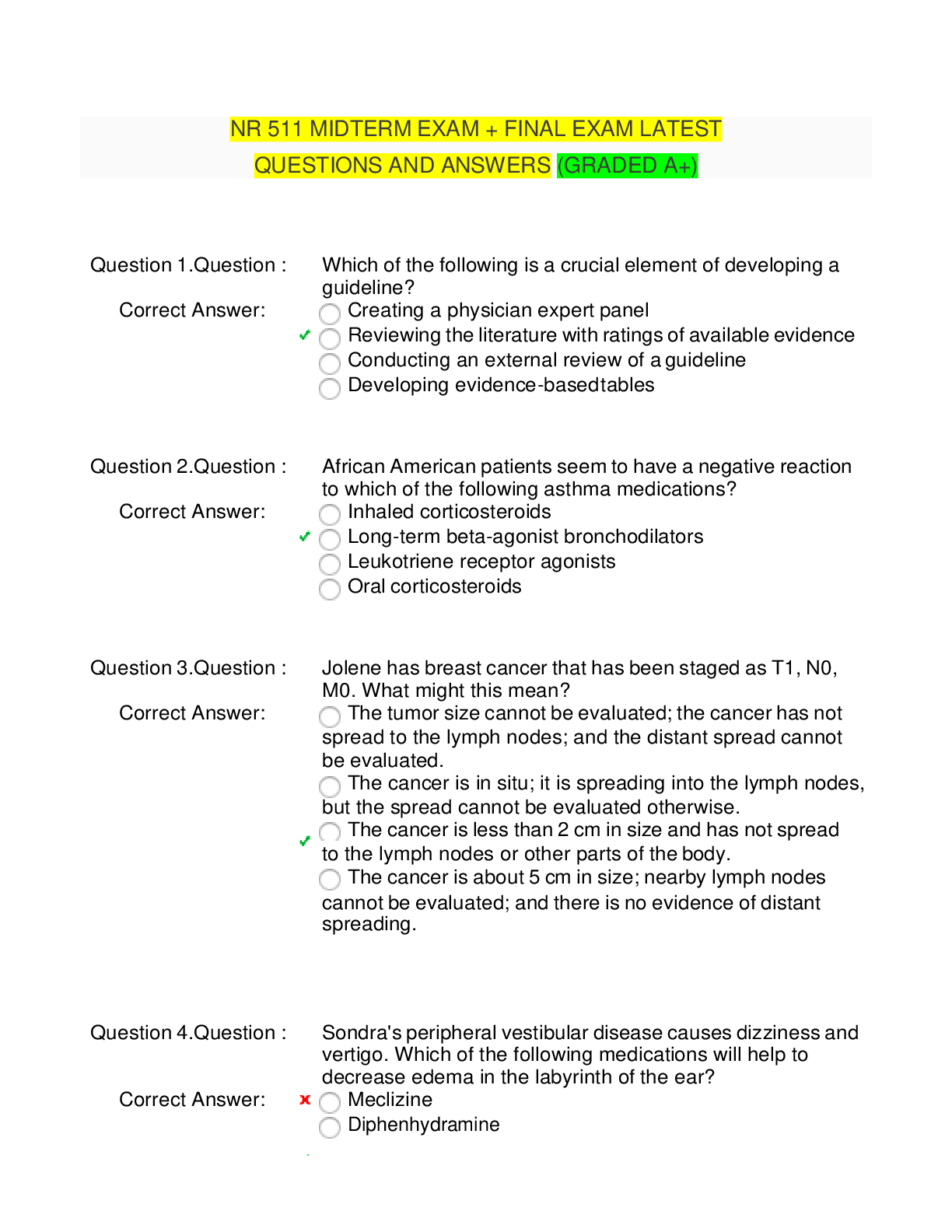

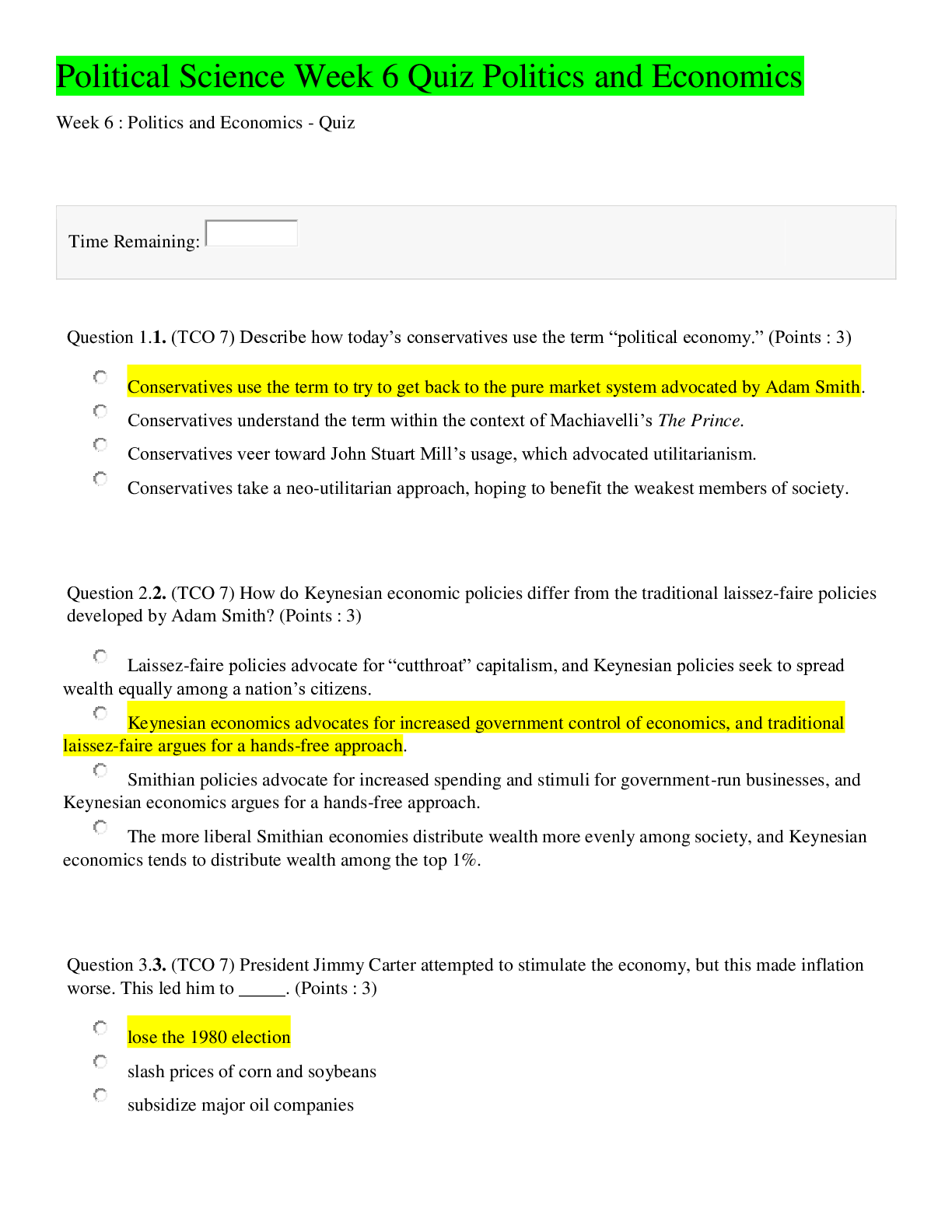
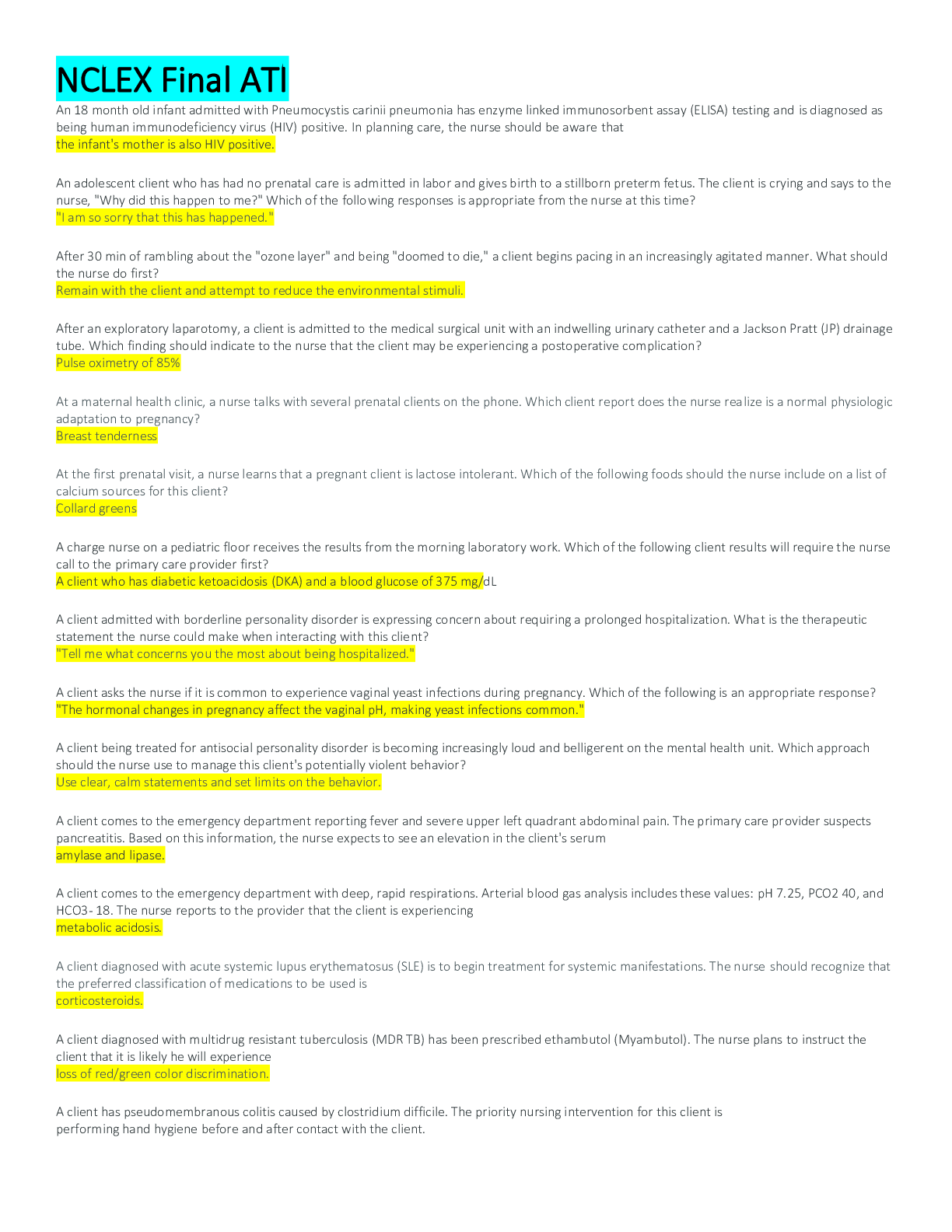
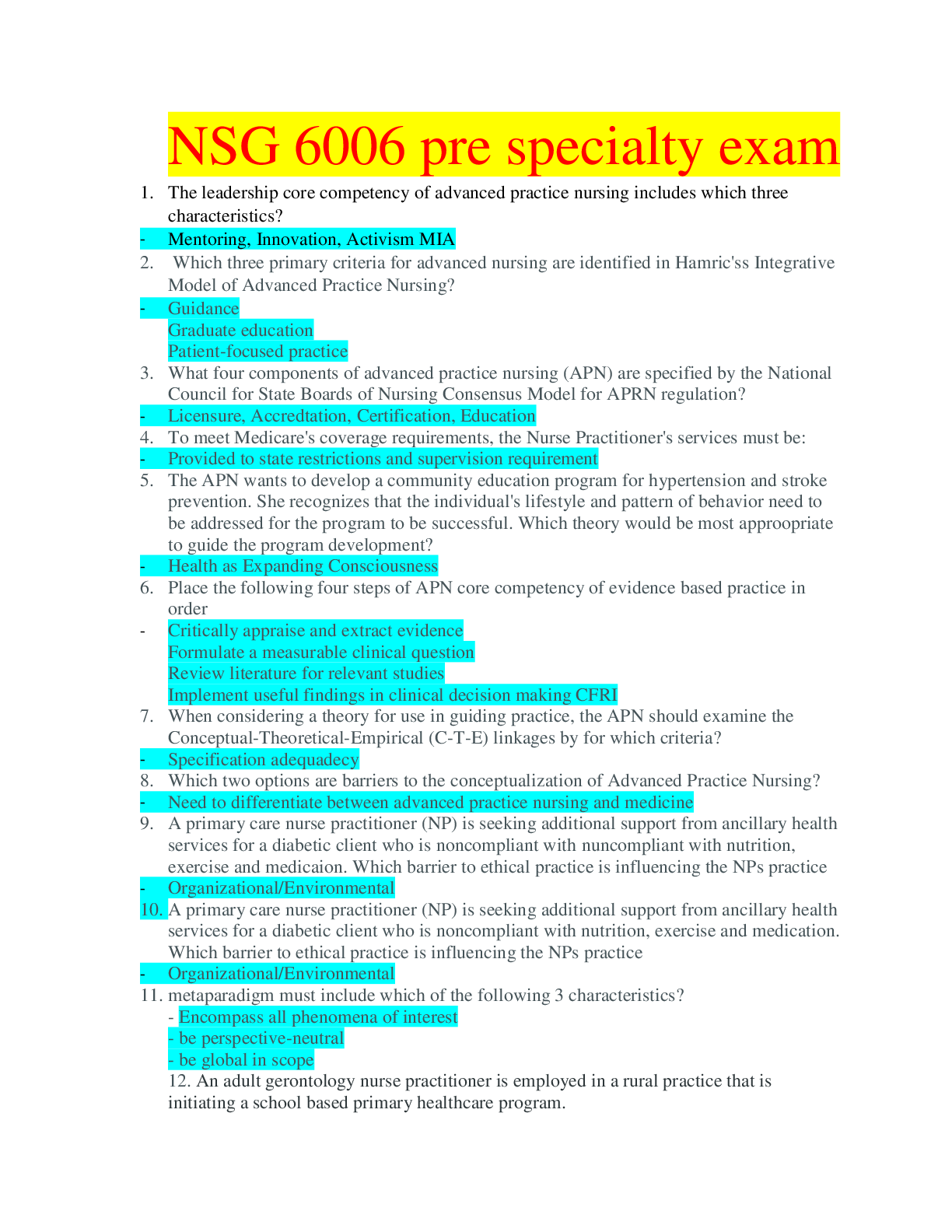
.png)
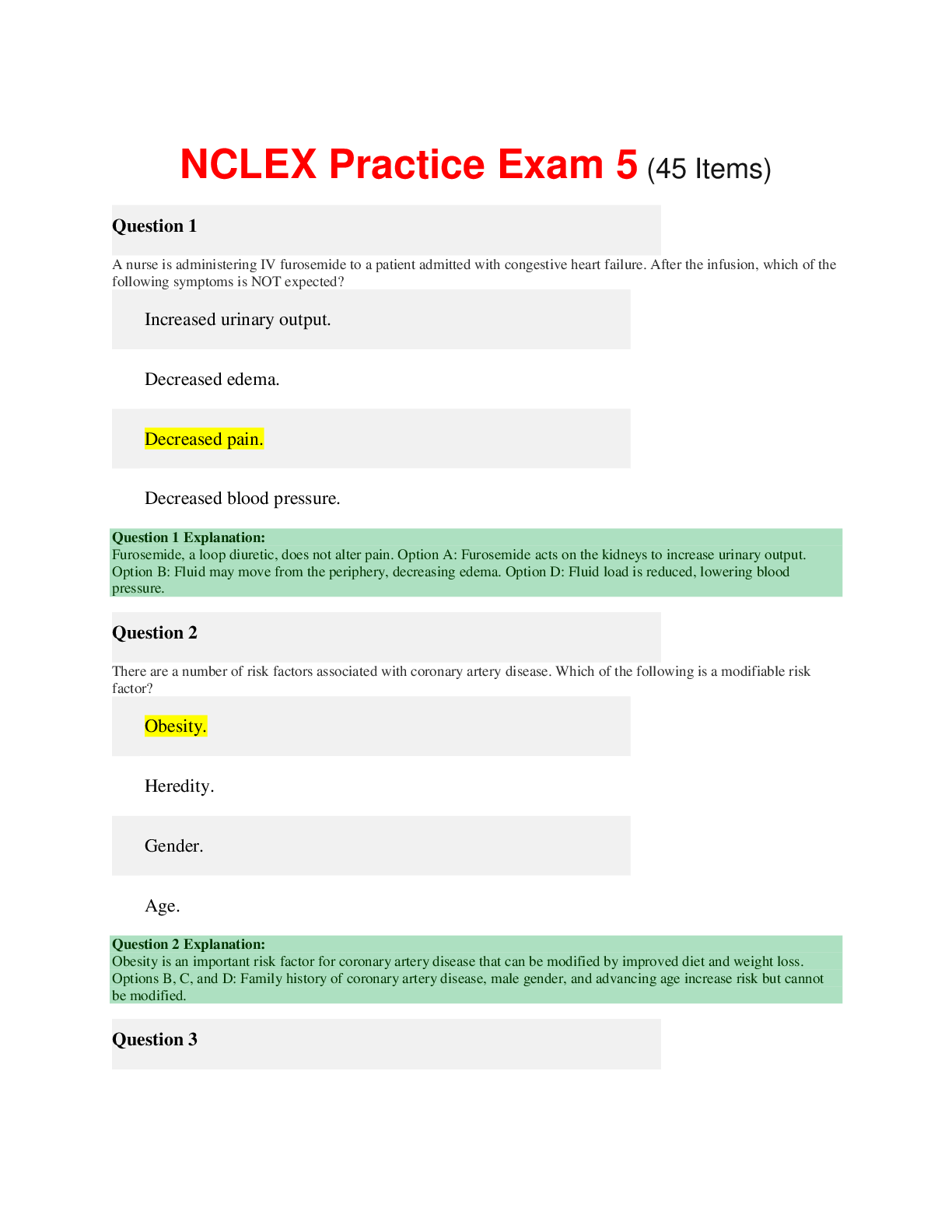
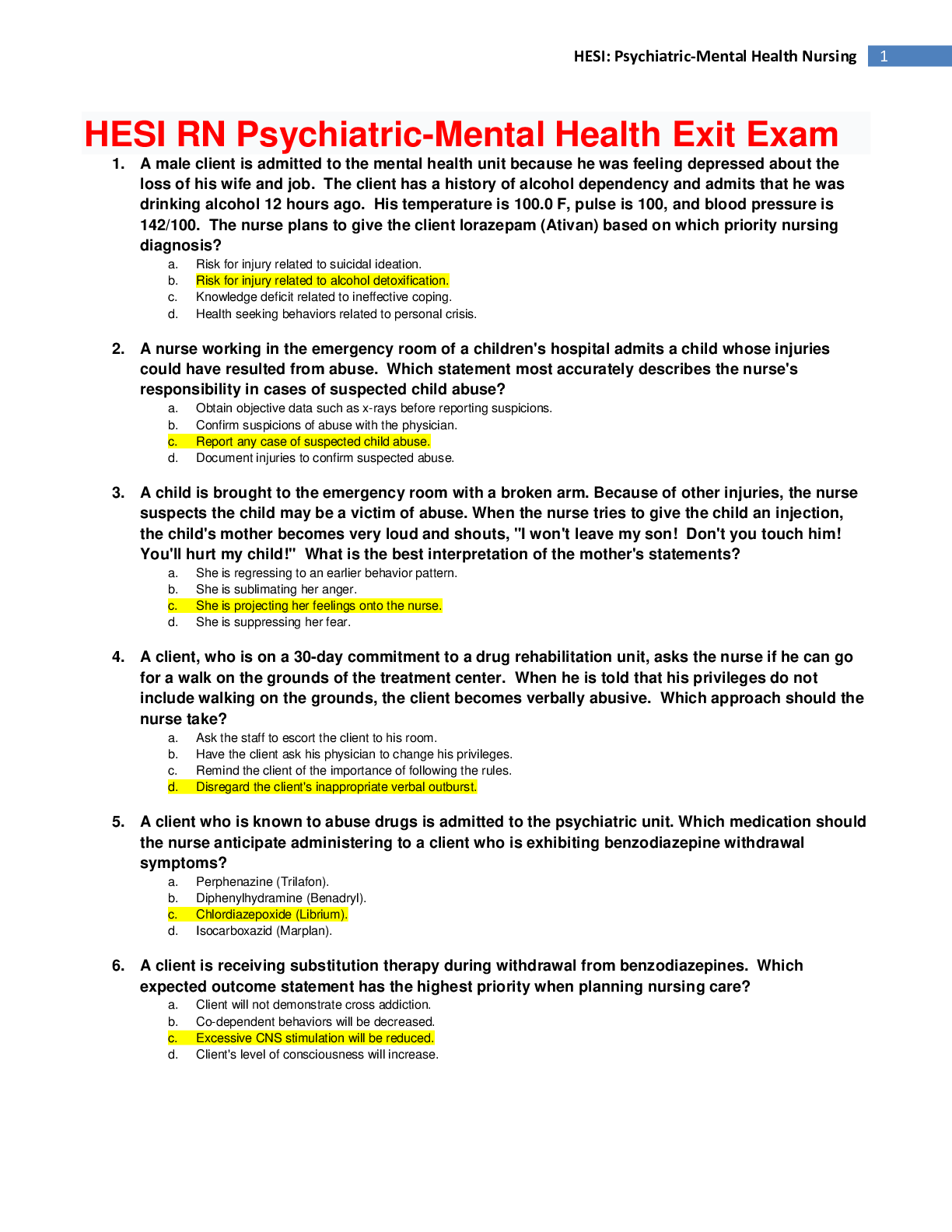
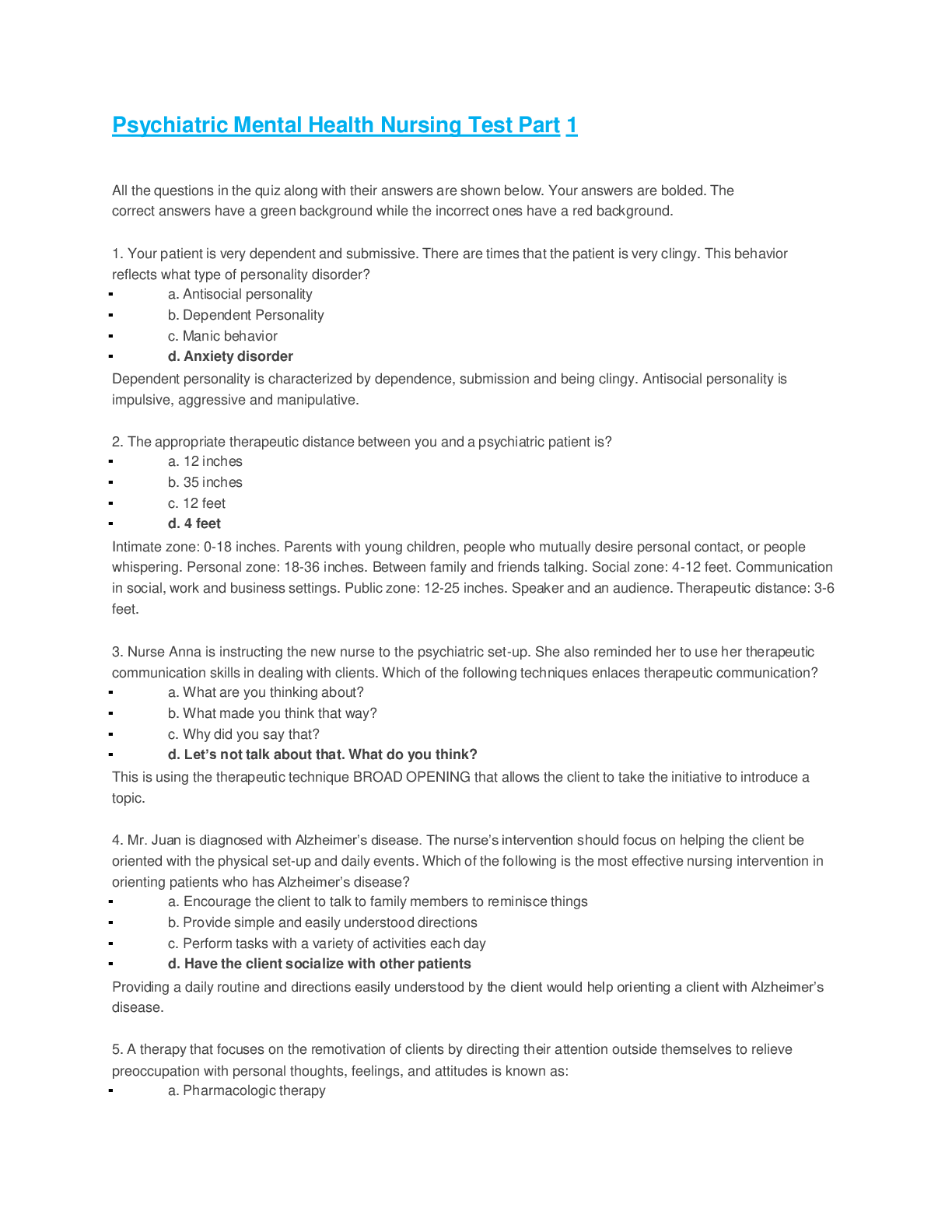
 – South university Savannah.png)
